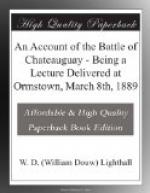It was soon found that a mistake had been made in attacking Canada. That happened which might be expected where bodies of men with inflated ideas of glory and no experience attack men fighting desperately for their homes, and officers and veterans who had seen such service as the Napoleonic wars. The British, with an astuteness which is oftener the character credited to their opponents, managed to get earliest word of the Declaration sent to their own forts on the Lakes, and promptly captured the American fort Michilimackinac. They then followed with the daring capture of the stronghold of Detroit, amply equipped and garrisoned, by a little handful of men under the heroic General Brock, who simply went before it and demanded its surrender, whereupon it was given up, together with the whole Territory of Michigan. The presence of such trained British officers as Brock and of army veterans in the ranks was a very great advantage. Poor Brock soon afterwards died in his memorable charge at the victory of Queenston Heights.
That year—the first of the War—is known as a succession of fiascos for the Americans. The other conspicuous aspect of it is that the attacked points were, with the exception of a little skirmishing at St. Regis and Lacolle, all in the Province of Upper Canada.
It was only towards the close of the campaign of the next year—1813—that Lower Canada was gravely threatened.
The Americans, emboldened by several successes, and having put a great many men into the field, believed that the struggle might easily be terminated by capturing Montreal. The advance upon Lower Canada took place under General James Wilkinson in chief command, with 8,826 men and 58 guns and howitzers.[1] He had intended to attack Kingston. “At Montreal, however,” wrote the Secretary of War, Armstrong, in phrases colored by the prevailing school of rhetoric, “you find the weaker place and the smallest force to encounter.... You hold a position which completely severs the enemy’s line of operations, and which, while it restrains all below, withers and perishes all above itself.” This great position—for it is so—Colonel Coffin[2] compares it to Vicksburg for natural strength—was to be approached by two routes: by Wilkinson himself in boats down the St Lawrence, and by Major-General Wade Hampton, his almost independent subordinate, from the Champlain border; and it was planned that the two armies should meet at the foot of Isle Perrot,[3] thence to strike together across the Lake to Lachine, and on to the city, which seems to have had not over, if as many as, a thousand regulars to defend it.




